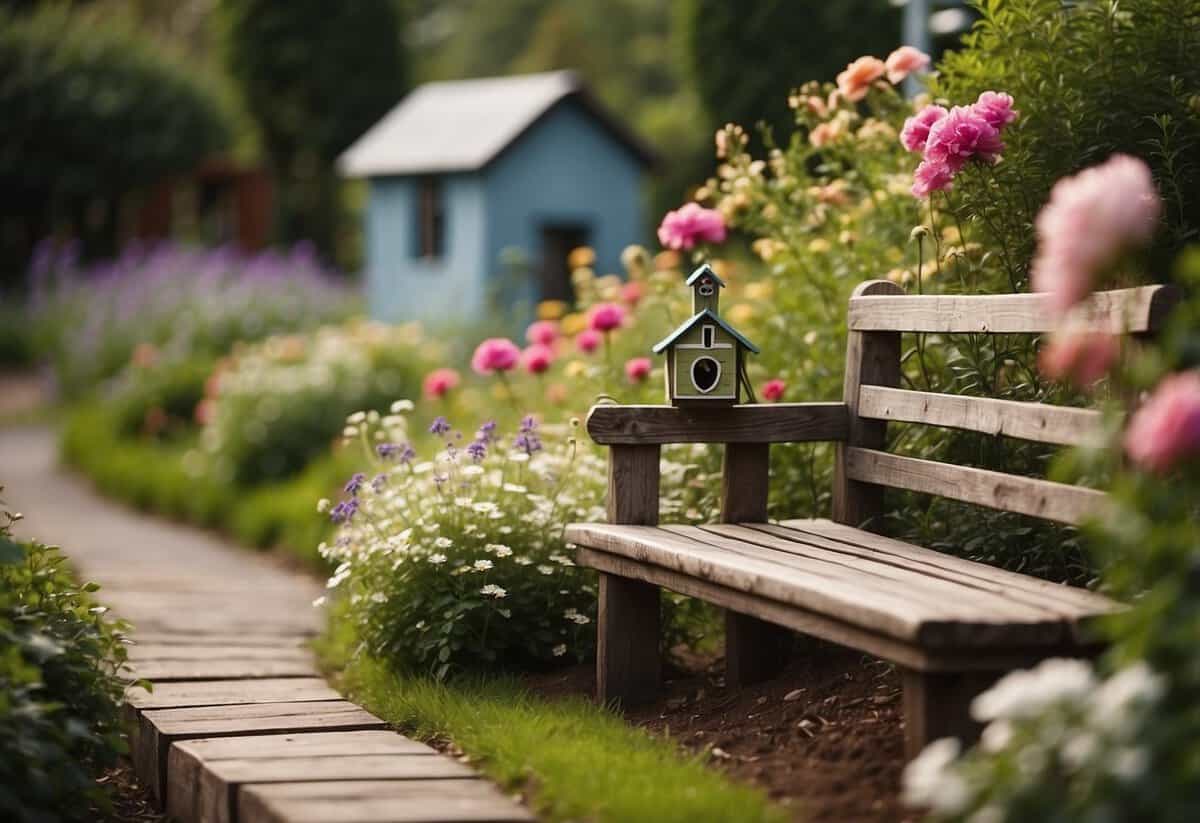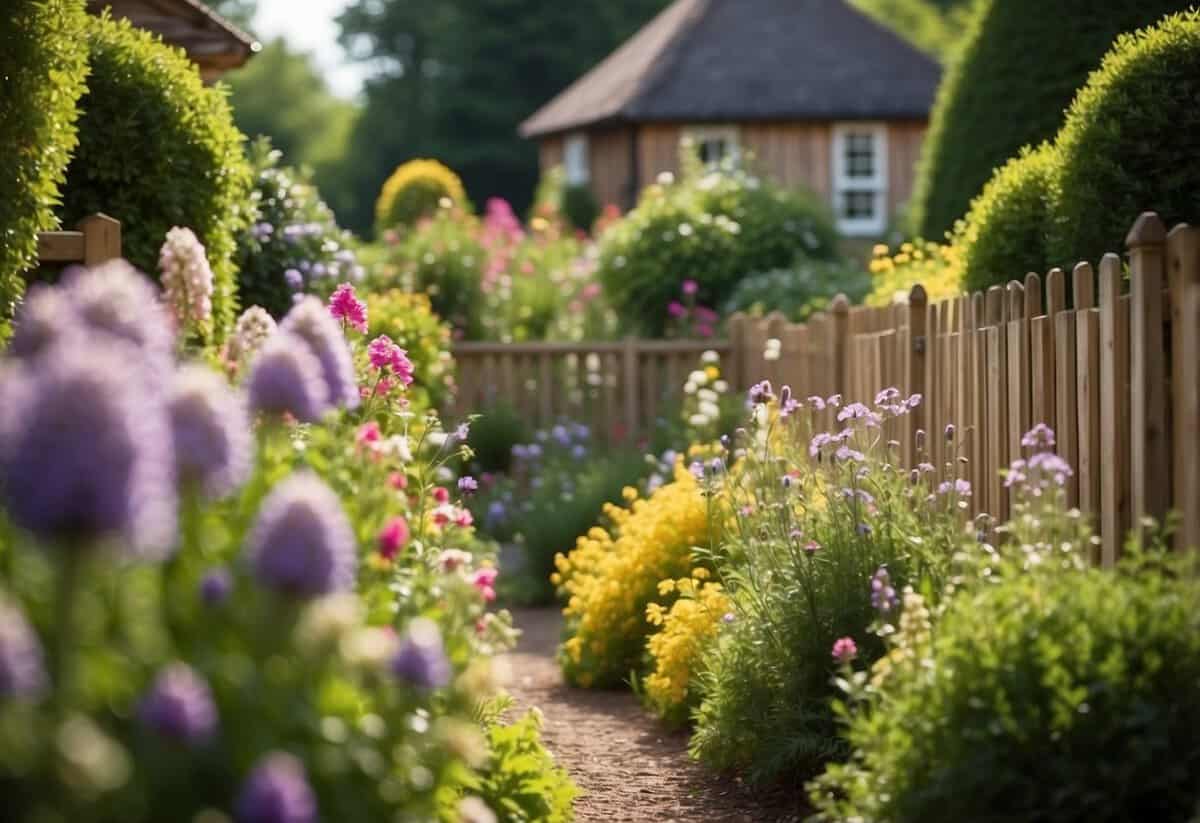Cottage Garden Ideas: Charming Ways to Transform Your Yard
Creating a cottage garden brings charm and beauty to any outdoor space. You might wonder how to blend flowers, herbs, and pathways to capture that idyllic, cozy style. This article will guide you through various ideas to help you design your perfect cottage garden.

Cottage gardens are known for their informal, lush look filled with colorful blooms and scented plants. Whether you have a large yard or a small plot, you’ll discover how to make the most of your space and create a delightful outdoor retreat.
1) Vintage Bird Bath

A vintage bird bath is a charming addition to your cottage garden. Its classic look adds a timeless feel to the space. You can find them in various styles, from ornate Victorian designs to simpler, rustic pieces.
Placing a stone bird bath among your flowers and shrubs can create a cozy corner. Birds will love visiting, and it gives you a lovely spot to watch them. Adding some stones to the shallower parts can also attract bees and butterflies to your garden.
2) Rustic Wooden Arbor

A rustic wooden arbor can add charm to your cottage garden. Its natural look blends beautifully with lush greenery and colorful flowers. You can use reclaimed wood for a truly authentic feel.
Place the arbor at the entrance to create a welcoming pathway. Let climbing plants like roses and ivy grow over it for a touch of magic.
For a simple project, you can follow ideas from this collection to build your own. It’s a great way to add character and style to your garden space.
3) Fairy Garden Accents

Adding fairy garden accents can bring a touch of magic to your cottage garden.
Consider placing miniature fairy houses among your flowers. These tiny homes can be made of wood, clay, or even painted rocks.
Use small plants and flowers to create cozy spots for your fairies. Creeping thyme, moss, and ferns are perfect choices.
Incorporate whimsical elements like tiny benches, birdbaths, or stepping stones. You can find these accessories at garden stores or make them yourself.
For more ideas, check out these fairy garden concepts and design inspirations.
4) Climbing Roses

Climbing roses can add height and beauty to your cottage garden. They come in many colors and scents, making them a delightful choice.
Try the Kiss Me Kate rose for its deep pink blooms and lemon-raspberry scent.
Pair climbing roses with clematis for a stunning display. The clematis will help cover the stems while the roses provide fragrance and color. Check out these ideas for inspiration.
5) Wicker Patio Furniture

Wicker patio furniture adds a charming touch to your cottage garden. It fits well with the cozy and inviting atmosphere you want to create.
You can find various styles, from traditional to modern. A wicker sofa set or a couple of wicker chairs offer a comfy place to relax and enjoy your garden.
Consider wicker furniture with cushions for added comfort. These pieces are durable and weather-resistant, perfect for outdoor use. They make your garden space both beautiful and functional.
6) Antique Garden Tools Display

An antique garden tools display can add a charming touch to your cottage garden. Look for vintage shovels, rakes, and watering cans at garage sales or flea markets.
You can hang these tools on a fence or arrange them artfully on a garden wall. This creates a nostalgic look and brings character to your outdoor space.
Combine tools with other vintage items like clay pots or iron planter boxes for a cohesive design.
7) Moss-Covered Pathways

Moss-covered pathways bring a magical touch to any garden. They create a soft, green carpet that feels like walking on a natural cushion.
Use mossy pathway ideas to enhance stone or brick paths. It’s important to find the right balance of sunlight and shade to help the moss thrive.
Add stepping stones for a practical yet whimsical pathway. This blend of moss and stone adds character and encourages you to explore your garden further.
8) Flowering Herbs

Flowering herbs add beauty and fragrance to your cottage garden. Anise Hyssop, with its tall purple spikes, is a favorite.
Lavender is another great choice, known for its soothing scent.
Chives also bloom with pretty purple flowers and can be used in cooking.
Consider adding these flowering herbs for a mix of color and function.
9) Cedar Garden Fence

A cedar garden fence adds charm and warmth to your cottage garden. Its natural look blends well with the lush greenery and vibrant flowers. It’s not just beautiful; cedar is also durable and resistant to rot and insects. This makes it a long-lasting choice.
You can choose from various styles, like picket or lattice, to suit your garden’s vibe. Plus, the pleasant cedar aroma is a bonus! For more garden fence ideas, check out these decorative garden fence ideas.
10) Painted Garden Signs

Painted garden signs add a personal touch to your cottage garden. They can guide visitors, label plants, or simply add charm.
Choose bright paint colors that stand out against greenery. Use weatherproof materials to ensure your signs last through rain and shine.
Get creative with designs. Write fun messages or paint images of flowers and veggies.
Design Principles

Creating a cottage garden involves setting up a relaxed layout while picking plants that will thrive and look great together. Balance and variety ensure an inviting space.
Creating A Relaxed Layout
A cottage garden should feel casual and organic. Start with winding paths instead of straight lines. This helps create a natural flow. Use materials like gravel, stepping stones, or bark chips for paths. Edges shouldn’t be rigid; let plants spill over walkways.
Avoid symmetry. Instead, mix different heights and textures. For structure, include a few small trees or shrubs. Place a rustic birdbath or a vintage bench in the garden. This gives a focal point and invites you to linger.
Think about adding curves and hidden spots. An arbor or trellis can break up the space visually. Use climbing plants like Clematis or roses on these structures to add height. Overall, the goal is to make the garden feel like it has evolved naturally over time.
Choosing The Right Plants
Choosing plants wisely is key. Opt for a mix of perennials, annuals, shrubs, and herbs. This variety ensures color and interest through different seasons. Popular choices include hollyhocks, foxgloves, and delphiniums. These plants bring height and classic charm.
Infusing herbs and vegetables within your flowers adds practicality. Plants like lavender, rosemary, and basil work well with blooms. Choose native plants when possible, as they are adapted to local conditions.
Don’t forget about seasonality. Plan for a garden that has something blooming throughout the year. For early spring, bulbs like daffodils and tulips are excellent. In summer, peonies and hydrangeas take center stage. Introduce evergreens or plants with interesting foliage for winter interest. This ensures that your cottage garden is visually appealing throughout the year.
Planting Techniques

When creating a cottage garden, using a mix of perennials and annuals along with smart layering techniques can result in a stunning, year-round display of blooms.
Mixing Perennials And Annuals
Perennials come back each year and form the backbone of your garden. Examples include hydrangeas and peonies. These plants provide structure and reliable blooms. On the other hand, annuals like petunias and zinnias add bursts of color and can be changed each year for variety.
By planting both, you get continual blooms. Start with perennials for a base, then add annuals in gaps. This mix enriches your garden’s palette, ensuring you always have something in bloom.
Layering For Visual Interest
Layering is key in creating depth. Place taller plants like hollyhocks at the back, medium-height plants like foxgloves in the middle, and shorter plants like coral bells at the front.
Using different heights prevents your garden from looking flat. For additional interest, combine varied textures and colors.
Underplanting trees with seasonal blooms like bulbs draws the eye to different levels, effectively utilizing all available space. Incorporate arbors for climbing plants to add vertical layers, enhancing the overall look.
Maintenance Tips

Keeping your cottage garden beautiful requires some regular care. Pruning and trimming keep plants healthy and tidy. Proper watering strategies ensure your garden thrives without wasting resources.
Pruning And Trimming
Regular pruning and trimming help maintain the shape and health of your plants. Tall plants, like roses and some perennials, need to be pruned to encourage strong growth and more blooms. Use sharp, clean tools to make precise cuts.
Trim overgrown branches and dead or damaged leaves. This prevents disease and promotes air circulation. Also, cutting back spent flowers, known as deadheading, can lead to more blossoms.
Tip: Prune early in the morning or late in the afternoon to avoid stressing the plants under the hot sun.
Watering Strategies
Watering your garden correctly ensures it stays lush and vibrant. Early morning watering is best, as it reduces evaporation and allows plants to absorb water before the heat of the day.
Use soaker hoses or drip irrigation for efficient watering. These methods deliver water directly to the roots, minimizing waste and reducing the risk of fungal diseases.
Consider mulching to retain moisture and reduce the frequency of watering. Mulch also helps to control weeds, providing a cleaner look to your garden.
Tip: Use a layer of mulch about two inches thick to get the best results for moisture retention and weed control.







